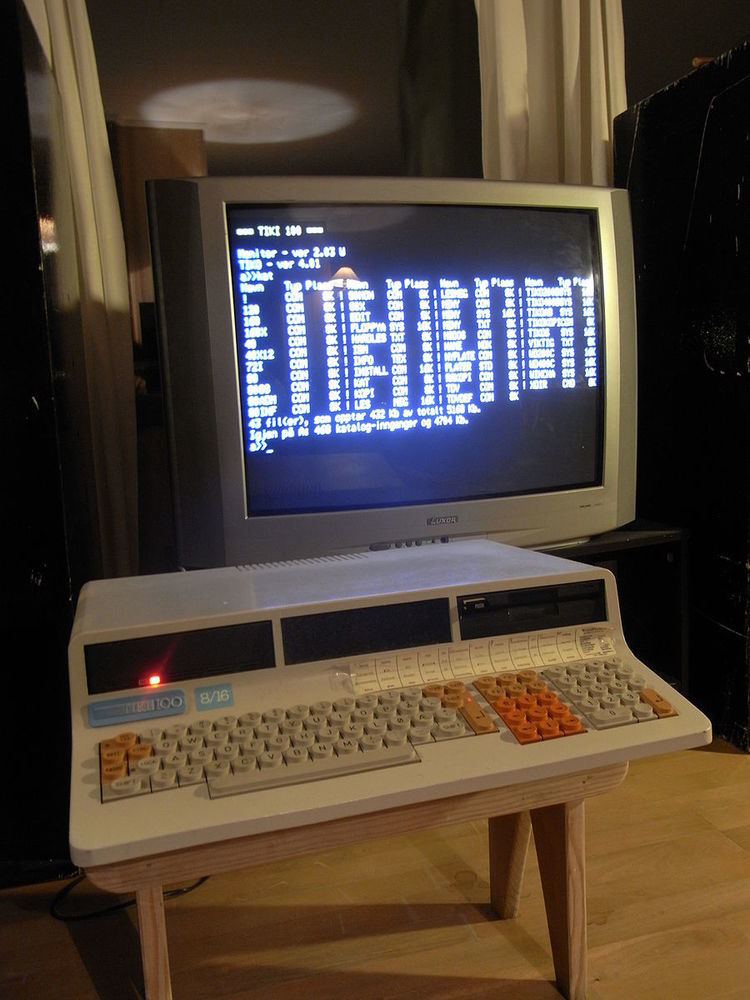Also known as Kontiki-100 | ||
 | ||
Release date April 1984; 32 years ago (1984-04) Introductory price NOK 12,000 (1984)(~USD 1,350) | ||
Tiki-100 was a desktop home/personal computer manufactured by Tiki Data of Oslo, Norway. The computer was launched in the spring of 1984 under the original name Kontiki-100, and was first and foremost intended for the emerging educational sector, especially for primary schools. Early prototypes had 4 KB ROM, and the '100' in the machine's name was based on the total KB amount of memory.
Contents
Development
It was decided by the Norwegian government that Norwegian schools should all use the same standardized computer in education. The Tiki-100 was developed as a direct response to this decision, and was as such greatly influenced by the specifications laid out by the government. One of the most influential of these specifications was compatibility with CP/M and the Z80 CPU.
Being designed as a computer intended for education, interactivity was prioritized. The machine was given good graphics capabilities for its time, along with decent sound. While other educational computers at the time had a main focus on BASIC and simple computer-science, the Tiki-100 had more focus on being a tool to aid in education and everyday-life situations. This put forth the need and memory requirements to run more complex applications.
The first prototype was built using wire-wrap and a bigger prototype case. Soon followed a prototype made on PCB, and there were very little changes from this prototype to the final product. The most significant changes was the change from Siemens keyboard switches to cheaper no-brand switches, along with the re-arranging of the analog video output connection. Very few, if any, revision A or B Tiki-100 computers ever hit the store shelves.
Tiki-100 was released under the original name 'Kontiki-100' in the spring of 1984. Thor Heyerdahl threatened to open a legal case on the use of the Kontiki name, with reference to the name of his famous raft. The name was changed to "Tiki-100" as a result. Around the same time, Computerworld magazine claimed the operating system "KP/M" was a direct copy of CP/M, due to KP/M being able to run CP/M software. As a response to these claims, KP/M was renamed "Tiko" to avoid direct association to CP/M and Digital Research.
Specifications
The computer was based on the Zilog Z80 CPU, and featured:
Software included:
Optional expansions:
The Tiki-100 has 3 different graphics modes, but no text-mode as it used bitmapped graphics only. However, terminal emulators provided options of 40, 80 or 160 by 25 characters, each option using one of the three modes. All of the graphics modes have hardware vertical scroll.
The rev.D
Later, an Intel 8088 based IBM PC compatible model running MS-DOS was made, somewhat confusingly called Tiki-100 Rev.D. In addition to being PC-compatible (including CGA-compatible graphics), it also contained a Z80 processor so that it could seamlessly run the original Tiki 100 software, although with a slightly reduced graphics specification due to the CGA. The two processors shared the same bus, and the Z80 programs still ran under the 8088 operating system.
